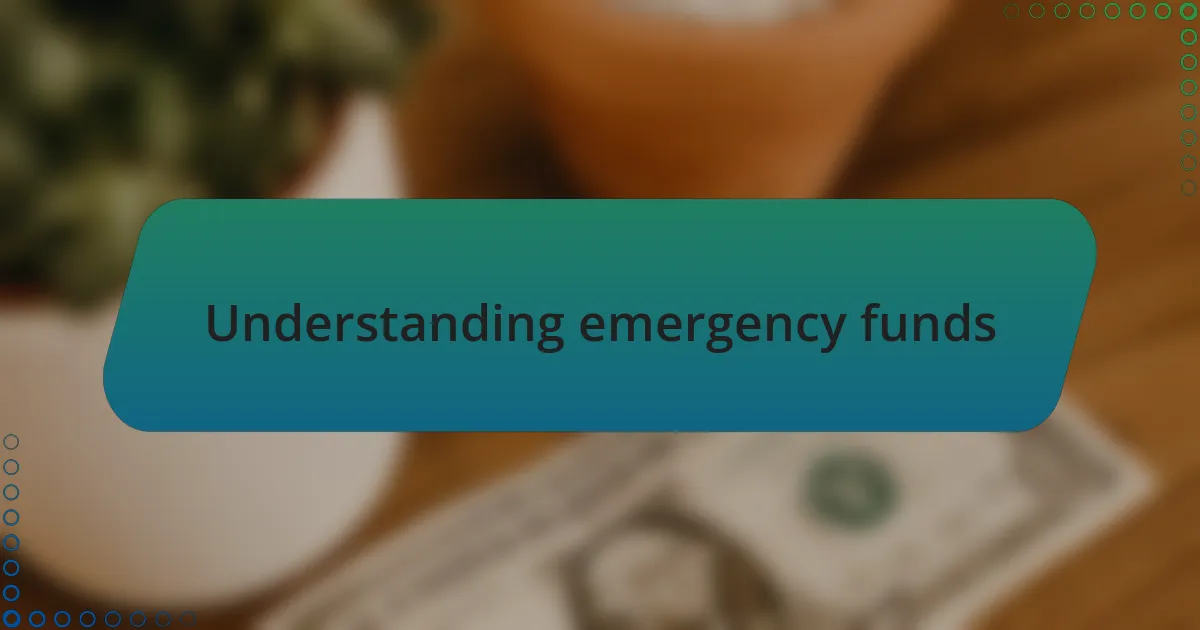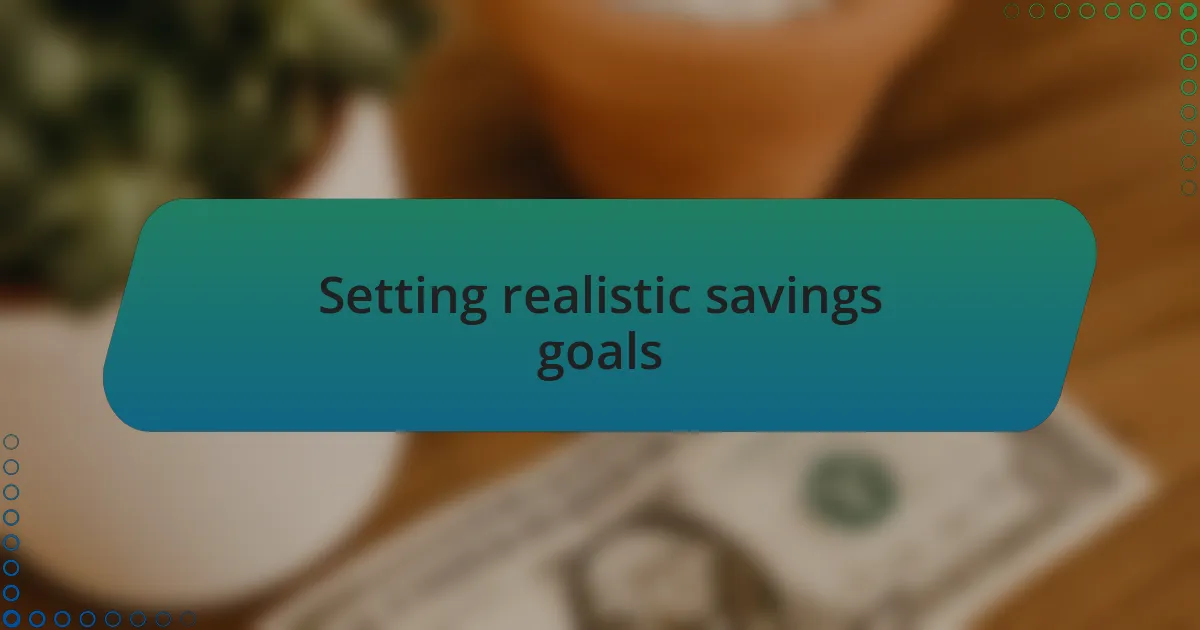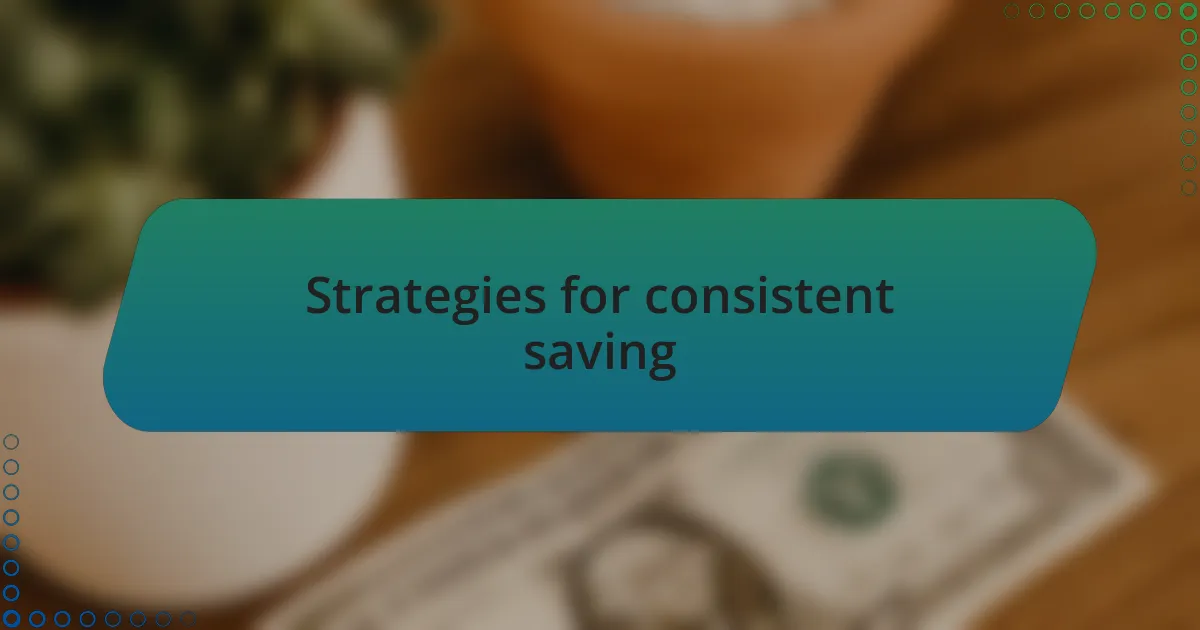Key takeaways:
- An emergency fund is crucial for covering unexpected expenses and preventing financial panic during crises.
- Setting realistic, manageable savings goals and adjusting them according to personal circumstances improves the effectiveness of saving.
- Automating savings, aligning them with paydays, and visualizing progress can enhance consistency in building an emergency fund.

Understanding emergency funds
An emergency fund serves as a financial safety net, designed to cover unexpected expenses like medical bills or car repairs. I still remember the relief I felt when my car broke down, and I could afford the repairs without stressing my monthly budget. Having set aside money for such moments provided me peace of mind that is invaluable.
Building an emergency fund can sometimes feel overwhelming, especially when you’re juggling multiple financial goals. Have you ever found yourself wondering where to even start? I’ve been there—starting small helped me tremendously. When I set aside just a little from each paycheck, I found that the fund grew faster than I anticipated.
The general guideline is to aim for three to six months’ worth of living expenses, but it’s okay to adjust that based on your personal circumstances. I learned that what works for someone else might not be feasible for you. For instance, I live in an area with a higher cost of living, so I aimed for a slightly larger buffer. This tailored approach made me feel more secure and ready for whatever life threw my way.

Importance of emergency funds
Having an emergency fund is essential because it provides a sense of security that allows you to navigate life’s uncertainties without panic. I recall the time when my partner lost their job unexpectedly; having that cushion meant we didn’t have to make rash financial decisions. How would I have handled that situation without an emergency fund? It’s a thought that sends shivers down my spine.
Emergency funds aren’t just about surviving crises; they’re about empowerment. When I managed to save up a few months’ worth of expenses, I felt a shift in my mindset. I could take calculated risks—like pursuing a new job opportunity—without the fear of immediate financial instability. Isn’t it incredible how financial stability can open up a world of possibilities?
Moreover, having a safety net protects you from falling into debt traps during emergencies. I’ve seen friends resort to high-interest credit cards when faced with sudden expenses. Trust me, those debts can spiral quickly! Having my fund ready meant I could tackle emergencies head-on without adding stress to my financial future. Wouldn’t you prefer to have control over how you respond to unexpected costs?

Setting realistic savings goals
Setting realistic savings goals is crucial in building an effective emergency fund. When I first started saving, I made the mistake of aiming too high, thinking I could stash away a significant amount each month. It wasn’t until I adjusted my goals to a more manageable number that I found success. Did you know that breaking down your ultimate savings target into smaller monthly goals can make it less daunting? I can attest that seeing those smaller victories really helped motivate me along the way.
Another strategy I employed was to align my savings goals with my own financial situation and lifestyle. I took a close look at my monthly expenses and determined what percentage I could comfortably save. By doing this, I was able to create a sustainable plan rather than setting myself up for failure by aiming for an unrealistic amount. Have you ever felt discouraged by lofty goals that didn’t reflect your reality? Trust me; I’ve been there, and it can be disheartening.
Lastly, flexibility is key. Life can throw curveballs, and your financial priorities may shift, just like mine did when I needed to help a family member in an emergency. I learned to review my goals regularly, adjusting them based on my circumstances and milestones achieved. This adaptability ensured that my savings journey remained effective and relevant. How often do you reassess your financial goals? I find that periodic check-ins keep me on track and motivated!

Strategies for consistent saving
One effective strategy I discovered for consistent saving is automating transfers to my savings account. When I first set this up, I felt a wave of relief; money would leave my checking account without me having to think about it. Have you ever noticed how easy it is to spend what’s in front of you? By automating my savings, I prioritized what was important to me without the daily temptation to spend. It feels empowering to see my savings grow effortlessly month by month.
Another tactic that worked surprisingly well involved leveraging my paycheck schedule. I found that timing my savings to coincide with payday was key. Each month, right after I received my salary, I would set aside a specific amount before tackling bills and expenses. It created a mental barrier that kept me from viewing those funds as disposable cash. Have you tried linking your savings to your income cycles? It really changed my outlook on financial management.
Lastly, I learned the value of keeping my savings visible. In the beginning, I would solely rely on my bank’s online portal, but I missed the physical aspect of saving. So, I created a visual tracker in my living space, marking each milestone achieved. It became more than just numbers; it inspired me every day as I passed by. It’s amazing how a simple visual can serve as a daily reminder of my goals. Have you considered how visualization could enhance your saving habits?